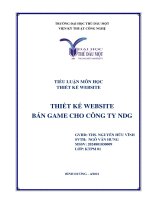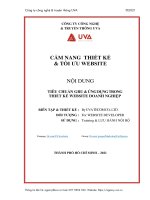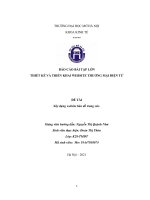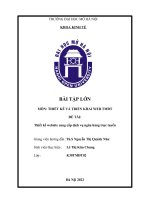Đồ án: Phân tích chiến lược kinh doanh và thiết kế website cho nhãn hàng thời trang
Bạn đang xem bản rút gọn của tài liệu. Xem và tải ngay bản đầy đủ của tài liệu tại đây (203.93 KB, 22 trang )
INTRODUCE
In the period of economic development and integration, every business is facing
opportunities and challenges. To maintain and survive as well as bring a
business up, creating a strong and reputable brand is not easy, there are many
businesses that have to go bankrupt because they do not have the right business
strategy. The purpose of this business plan is to grow a blueprint of the
company's vision and strategy and then use the plan as a guide to develop the
business. This business plan will also be used to bring together the various
elements of the company to create a consistent system of customer satisfaction
and sustained returns.
Chapter 1: Business Plan Overview:
1.1 Company Summary:
1.1.1 The potential of the fashion industry:
Fashion has always been at the forefront of innovation — from the invention of
the sewing machine to the rise of e-commerce. Like tech, fashion is
forward-looking and cyclical.
The fashion sector is also one of the largest industries in the world, estimated to
be worth more than $3T by the end of the decade, according to CB Insights’
Industry Analyst Consensus.
And today, fashion technology is growing at a faster pace than ever. Robots that
sew and cut fabric, AI algorithms that predict style trends, clothes to be worn in
virtual reality — an array of innovations show how technology is automating,
personalizing, and speeding up the fashion space.
Seizing the opportunity to open more revenue streams and business models,
fashion companies are partnering with technology providers, snapping up
startups, and even building their own tech.
1.1.2 . Reasons for choosing a product/service industry
Nowadays, as the standard of living increases and technology develops, we tend
to care and invest more in beauty. In particular, women aged 20 and over are in
need of health and beauty care, especially external beauty in order to enhance
the maximum beauty of women as well as for them to express their personality .
Currently, the clothing business market is developing rapidly. Besides the
personal benefits of women, this industry also plays an important role in the
development of Vietnam. Derived from their own needs and understanding of
the needs of the market through surveys, research, and research. Our group
decided to choose women's clothing for business with the desire to give women
more choices of clothes to enhance the beauty of women, especially in the
Vietnamese market to access prestigious, economical products.
1.1.3 Business goal:
We launched our brand with the goal that within five years, we can make it the
leading brand in the country in women's fashion. After achieving the desired
popularity and customer base, we will aim to open several branches for the
brand abroad, thereby developing more strongly in this field.
1.1.4. Keys to Success
In order to succeed in the clothing industry, Honey must:
• Display a wide range of sizes, colors and designs to suit the needs and goals of
our customers, providing customers with personalized, high-quality service.
• There are fashion design recommendations to match the customer's style.
• Continuously review our inventory and sales and adjust our inventory levels
accordingly.
Always plan and customer care to manage complaints, perform customer and
employee feedback, manage supplier accounts, and anticipate potential
conflicts.
1.2. BUSINESS PLAN'S EXECUTIVE SUMMARY
1.2.1. E-commerce Model
1.2.1.1. Types of E-commerce: B2C model
Honey sells our own clothing product directly to consumers who are the end users of Honey products. So our company can be referred to as the B2C model.
1.2.1.2. Business Models: E-tailer
Honey has an online retail store, so that customers can read and view detailed
information of our product in the most convenient way, and the facilitating
customers to pay online when buying retail will be a competitive advantage for
the company.
Honey purchases raw materials from suppliers, then we manufacture in their
own factory, after that finished-goods will be distributed to our outlets and our
customers who order through our website.
1.2.1.3. Revenue Models
The sales revenue model works well for Honey online e-tailer, which only
requires transactions of small cash amounts. Convenience and flexibility for
customers therefore can be guaranteed because all transactions are made online
via digital payment mediums.
1.2.2. Payment Method
Customers can refer to the following payment methods and select the
appropriate method:
➢ For international order:
Option 1: Online payment via MasterCard, Visa, Discover and American
Express
Option 2: Pay via PayPal
➢ For national order:
Option 1: Payment for Goods Receipt (COD – Cash on Delivery)
Option 2: Online payment via credit/debit card
Option 3: Pay via online wallet
1.2.3. Delivery Method
Upon receiving the order information, the salesman will contact the customer
through the phone number or email that the customer leaves to confirm the
order. For orders paid via e-wallet or bank account will be required to pay after
24 hours after placing an order, and in case of payment upon receipt of goods,
the sales staff will confirm with the customer. The order will then be packed and
delivered to the carrier at the customer's address.
The exact delivery time depends on the geographical distance between the
Buyer and the Seller.
1.2.4. Customer Support Service
➢ Exchange policy
• Purchased items can be exchanged within 7 days of receipt.
• For hygiene reasons, clothing items cannot be returned.
• To be eligible for an exchange, your items must be unused and in the same
condition as you purchased them originally.
• Discounted items cannot be exchanged.
• Customers can only redeem once per receipt.
• Redeemed items must be of equal or higher value.
• In the event that there is no item you want to redeem, the amount will be
converted into a Gift Voucher valid for 1 year.
• Customer will be responsible for the payment of shipping charges in order to
exchange your items.
• Items must be sent back within 7 business days of delivery.
• Damaged, defective or incorrect items must be notified within 3 days of
receipt.
• Original receipt must be provided upon exchange.
➢ Warranty policy
• Applies only to products with Warranty Cards.
• Free warranty within 30 days from the day of purchase.
• After 30 days warranty is still available however depends on the product &
condition. This service incurs a warranty fee.
• Warranty Card & receipt must be provided.
1.2.5. Regulations activities
Honey freely negotiates on the basis of respecting the legitimate rights and
interests of the customer involved in activities of trading in products and
services and not on the contrary with the rule of law. Products and services
participating in the transaction on Honey fully meet the provisions of relevant
laws, not in cases of business ban, advertising banned in accordance with the
provisions of law.
CHAPTER 02: ANALYSIS PLAN
I.
General Analysis:
1. Market and target customer analysis
Currently, the clothing market is a potential market with few barriers to
entry and many customers. Clothing is an essential item in society,
especially with today's increasing demand for self-beautification.
However, because there are few barriers to entering the market, the
number of competitors that the brand has to compete with is very high,
including domestic and big foreign brands. This requires the brand to
have a good source of products, with prices appropriate to the market
needs and target customers.
Our brand targets women from 16-40 years old, which is the age when
people often have a high demand for shopping for themselves and their
families.
2.Analyze Competitors
➢ Indirect Competitors
The indirect competitor of Honey is any brand that sells things for women such
as shoes, clothing,.. There are tons of brands as well as local shops, both online
and offline, which sell these things. In general, the indirect competitors of
Honey are huge.
➢ Direct Competitors
Honey is a niche brand that focuses its efforts on a large part of the small
market and does not compete for market share in a large market, but will follow
the business needs of the market. Therefore, Honey ‘s competitors are
small brands such as local brands. The common feature of these brands is that
they have a unique appearance in terms of both products and services,
impressing customers, especially raising brand awareness among young people.
Some local brands that can be considered as the indirect competitors of Honey
are COOLMATE, Sly, HBS, ZOMBIE, HADES, NOWSAIGON,....
2.1 Rivalry among the Existing Competitors
If the rivalry among the existing players in an industry is intense then it will
drive down prices and decrease the overall profitability of the industry. Honey
operates in a very competitive industry. This competition does take a
toll on the overall long-term profitability of the organization.
How Honey can tackle Intense Rivalry among the Existing
Competitors in the Clothing Stores industry?
• By building a sustainable differentiation
• By building scale so that it can compete better
• Collaborating with competitors to increase the market size rather than just
competing for a small market.
2.2 Potential competitors
With businesses and private shops, establishing a retail network in our country's
market is a big threat:
- Small organization size, not high management level
- Financial potential is quite good
- Much of the business is based on trust
- This system is accounting for a huge market share in the fashion industry.
2.3 Threats of New Entrants
New entrants will bring innovation, new ways of doing things and put pressure
on Honey through lower pricing strategy, reducing costs, and providing
new value propositions to the customers. Honey has to manage all these
challenges and build effective barriers to safeguard its competitive edge.
How Honey can tackle the Threats of New Entrants?
• By innovating new products and services. New products not only bring new
customers to the fold but also give old customers a reason to buy Honey’s
products.
• By building economies of scale so that it can lower the fixed cost per unit.
2.4 Substitute Products and Services
Threat of Substitute Products / Services
When a new product or service meets a similar customer needs in different
ways, industry profitability suffers. For example, products like shoes or clothing
are substitutes for clothing brands like Honey. The threat of a substitute product
or service is high if it offers a value proposition that is uniquely different from
present offerings of the industry.
How Honey can tackle the Threat of Substitute Products /
Services?
• By being service oriented rather than just product oriented.
• By understanding the core need of the customer rather than what the
customer is buying.
• By increasing the switching cost for the customers.
3) Customer
Bargaining Power of Customers
Buyers are often a demanding lot. They want to buy the best offerings available
by paying the minimum price as possible. This put pressure on Honey
profitability in
the long run. The smaller and more powerful the customer base is of Honey the
higher the bargaining power of the customers and higher their ability to seek
increasing discounts and offers.
How Honey can tackle the Bargaining Power of Customers?
• By building a large base of customers. This will be helpful in two ways. It
will reduce the bargaining power of the buyers plus it will provide an
opportunity to the firm to streamline its sales and production process.
• By rapidly innovating new products. Customers often seek discounts and
offerings on established products so if Honey keeps on coming up with
new products then it can limit the bargaining power of buyers.
• New products will also reduce the defection of existing customers of
Honey to its competitors.
4) Suppliers
Bargaining Power of the Suppliers
Almost all the companies in this industry buy their raw material from numerous
suppliers. Suppliers in dominant position can decrease the margins Honey can
earn in the market. Powerful suppliers in the Services sector use their
negotiating power to extract higher prices from the firms in the clothing field.
The overall impact of higher supplier bargaining power is that it lowers the
overall profitability of Honey.
How Honey can tackle Bargaining Power of the Suppliers?
• By building an efficient supply chain with multiple suppliers.
• By experimenting with product designs using different materials so that if the
prices go up of one raw material, then the company can shift to another.
5) Management team
- Chairman: oversees the overall strategic direction and progress of the
company. Specific areas include operational soundness, financial stability,
and long- term well-being of the corporation.
- Chief Executive Officer: the main responsibility is to maintain a strategic
fit between the corporate resources and external factors. Responsibilities
include running the overall day-to-day operations, technological and
operational soundness, and financial stability.
- Research & Development department: responsible for innovations in
design, products, and style. This department is responsible for creating
innovative new products to keep companies a step ahead of the
competition. R&D department to improve existing consumer products,
and to explore new ways of producing them.
- Operations department: ensures that the production process is completed
from start to finish. These production processes need to line up with the
goals and functions of other departments within a company.
- Quality management department: to ensure profit margins by reducing
inefficiencies, operations errors and product defects. They measure,
analyze and report on quality.
- Marketing & sales department: to promote products and services based on
thorough marketing research into customer demands. The sales function
is to support the marketing department and it ensures that customers are
provided with a quality product in a timely manner.
- Finance department: they are responsible for acquiring funds for the firm,
managing funds within the organization and planning for the expenditure
of funds on various assets.
- Administration department: is responsible for providing administrative
aid in five areas of a business: information management systems, human
resources, payroll, acquisition and communication.
- Legal Affairs department: is a ministerial unit which performs the
advisory and regulatory functions via legal framework in the information
and communications sectors; the implementation of legal work; control
on administrative procedures and receiving and handling complaints and
inquiries of individuals and organizations on administrative regulations in
the sector in accordance with the provisions of law.
6) FINANCIAL PLAN
6.1) Key Business Assumptions
- Assumptions of interest and tax rates are based on various scenarios including
"worst case" and these will be adjusted upon completion of the initial capital
calculation and establishment of Honey
- Assume Honey staffing burden at 20% of payroll to deliver above -average
benefits to our employees.
- Assume that Vietnam's economy continues to grow steadily in the future.
- Assume the continued move towards converging technology in the clothing
manufacturing industry.
6.2) Investment Objectives
• Minimize costs and maximize profits.
• Maximum number of products sold in the market.
• Invest to improve product quality.
• Investing in depth to innovate technology.
6.3) Start-up Capital
Start-up Capital: VND 10.000.000.000
Capital (VNĐ)
Owner’s equity
7.000.000.000
Capital from partners
3.000.000.000
6.4) Set-up Cost
Set-up Cost: 9.000.000.000 VND and 1.000.000.000 VND to provide of arising
during implementation
Department
Cost (VNĐ)
Customer support service
250.000.000
Finance
400.000.000
Technology
1.100.000.000
Operation
2.000.000.000
Payment and delivery
150.000.000
Marketing and sales
1.100.000.000
Total
5.000.000.000
6.5) Key Financial Indicators
• Expected sales: Honey is expected to increase sales by an average of 18%
per year.
• Gross Profit Margin: Average gross profit margin based on sales of
products.
• All costs: expected to grow at a rate of 7% per year.
• Establishment, legal, licensing costs.
• Purchase machinery, technology and equipment.
• Hiring employees.
• Promotion.
• Intangible fixed assets.
• Prepaid expenses.
• Environmental costs.
• Provisions and other expenses.
II.Business Plan:
1. Marketing Strategy:
1.1 4Ps:
Product:
At Honey, what we do is to create new clothing designs all year round and only
produce a limited number before moving on to the next designs. With these
abbreviated production runs, designs get sold out faster, and there are virtually
no leftovers. The higher number of designs makes for more variety and a wider
range of choices for the customer. At the same time, the smaller amount of
clothes per design also considerably increases its value for the customer because
there will be fewer people who own the same outfit that they have just bought.
In other words, there is higher exclusivity and, thus, more appeal.
Honey does all the manufacturing in our facilities instead of outsourcing. This
ensures that we have complete control over the quality of our clothing, and it
also cuts down a considerable amount of time on the overall production process.
Price
Honey’s prices are affordable compared to other apparel in our class. However,
products are still considered high fashion, and the company implements a
premium pricing strategy, so the price tag might still be a bit expensive for the
ordinary shopper.
Nevertheless, because one of the primary objectives of Honey is affordability,
Honey always finds ways to minimize production costs so that we can offer its
products at lower prices and make them more accessible to the average
customer who would like to wear great clothes without burning a hole in their
pocket.
Place
Honey has actively pursued online channels of selling. Aside from our official
website in Havana, where you can browse and purchase most of its products,
Honey has a plan to partner with several multi-brand online outlets, effectively
increasing our reach into the market in VietNam. Online channels are also a
great way to market to the younger crowd that spends a lot of time on social
media.
Promotion
Advertising on social networks:
-Facebook Ads
-Search engine optimization
-Promotion activities
1.2 Social Marketing :
-Facebook Marketing:
-Benefits:
1. Micro-target our exact audiences
3. Better ad types for your business needs
4. They can be affordable and low cost
5. Facebook ads can give results very fast
1.3 Traditional online marketing:
- Display ad marketing
Honey uses banner ads to advertise our product on websites and social
media.
- Email marketing
A notification will appear whenever you access our website anđ ask the
customer whether they want to know or receive more information about
us. If they want to, they can enter their email address. That is how email
marketing works in our case.
- Affiliate marketing.
We are planning to hire some KOLs or influencers to promote our
product on their social channel.
1.4 Location-based marketing:
Geo-aware techniques: A location-based service that creates a virtual perimeter
or geofence with smartphone data, WiFi, or GPS to trigger a desired marketing
action.
Example: Customers walk past our store and receive a push notification with the
message: ‘Sale ends today! Buy 1 skirt, get 1 free’.
2) Business Strategy:
Focus/ market niche:
A niche market is a segment of a larger market that can be defined by its own
unique needs, preferences, or identity that makes it different from the market at
large. In our case, within the market for women's clothes are many different
segments or niches. Therefore, Honey apply this strategy as we aim to sell
clothing that follows a gentle style.
3) Pricing Strategy:
Dynamic Pricing-Flash marketing:
Honey usually sells up our products in some particular period of time.
CHAPTER 03: BUILDING THE WEBSITE
3.1. OVERVIEW
3.1.1. General information.
Honey Fashion will register business website under:
- Domain name: honeyfashion.com
- URL: />Current link to access demo website: />Honey Fashion’s website focus on three goals:
- Provide information about: our brand, contact information, brand
meaning
- Focus on displaying product images and information.
- Customer service
3.1.2. Main idea
The website uses two primary colors, white and green leaves, expressing
simplicity and youthfulness. Besides, it also combines red tones to attract
customers' eyes when the product is on sale.
The logo is a combination of two colors: yellow and green.
- Yellow represents honey - also the meaning of the brand name.
- Green is the primary color of the website. In addition, it can be associated
with the environment.
The overall website is designed with minimalism and beautifully so that
customers can easily observe and manipulate it.
3.1.3. Website requirements
- Main language is English
- Beautifully designed, easy to see, easy to attract customers to look at the
outstanding information.
- Accessible by any browser or electronic device.
3.2. STRUCTURE OF WEBSITE
3.2.1. Feature description
Header: Display brand name, search engine, login area, or account registration
and shopping cart.
Home page: This is the default page displayed first when a customer visits the
website's link. The homepage will include a banner containing information
about new products, discounts, or best-selling products. There is also contact
information and the brand's social media in the Footer section.
New arrivals page: Display products in the latest collection
BEST-SELLER page: Display the products purchased by the most customers.
All Collections page: Customers can choose to view all products (in all
collections) or select the collection they consider. In addition, customers can
filter to find the products they want by price, size, or product properties (latest,
oldest, best-sellers,...).
Blog page: Display articles related to the brand or collection.
ABOUT US page: Display the logo, a general introduction to the meaning and
purpose of the brand.
Footer: Display a short intro, contact information, and Facebook address.
3.2. Description of the transaction.
Step 01: Sign up to receive information
When customers visit the website, a popup will appear asking to register to
receive information. Customers can choose to enter the email or ignore it.
Step 02: View and search products
Customers can view products on the homepage or other pages (New arrivals,
best-sellers) and choose the products they want.
Customers can also enter keywords such as name or category in the search
engine (Example: Dress, crop top) or use the filter tool.
Step 03: Purchasing process
After selecting the product needed, the customer chooses size and color and
then "Add to cart."
Customers can choose to pay immediately in the mini-cart frame or review the
cart and then pay.
The checkout process will require the customer to enter their name, address,
email, shipping, and payment methods. If the customer is already logged in to
the account, the order information will be saved and easily tracked. If you do
not have an account, the shop will still send order information via the email you
filled in.
Step 04: Customer service
If there are any questions, customers can contact via hotline, Zalo or send a
message.
CHAPTER 04: CONCLUSION
4.1. EFFECTIVENESS EVALUATION
4.1.1. Advantage
When a woman wears beautiful clothes to show her personality, she will be
most confident and that is the value Honey brings to customers. To give an
example, According to our marketing strategy, our website visitors can refer to
the available clothing patterns and from there can come up with ideas tailored to
each individual. multiply. Besides, our staff appear with a customer-oriented
mindset, providing full support at any time.
Although Honey is a new brand in this industry, we plan to strengthen our
capacity through a pricing strategy with high quality coaches. It is the
cooperation from enthusiastic, creative staff that will help customers to trust
more, along with the affordable prices made at mid-range will make the
customer experience the best.
4.1.2. Future Potential
In terms of market demand: More than 50% of the Vietnamese population is
female in the young age segment, 18 years or older, and their beauty and selfexpression needs are clearly expressed. Clothing is one of the trends to express
the personality of young people and that is the reason for the company to reach
customers by e-commerce.
About company potential:
Our brand has a custom design service according to the requirements of
customers. We are not only the ones who take customers' ideas to create
products, but also comment and edit so that the final product is the most
beautiful and unique thing.
The service is based on value, the staff is enthusiastic and dedicated to bring the
best to customers. The company's broad customer segment makes it easy for the
company to expand its market share.
4.1.3. Evaluation:
4.1.3.1. Achievement:
- E-commerce business plans involve almost every general element according to
the standard in the outline. In addition, each element of both analysis and
strategy is described in detail.
- The plan is presented in an exact and concise way.
- The design of the website logo fits well with the characteristics and orientation
of the company on both the aesthetical and content side.
- Data used in the plan is updated continually throughout the time so that the
company can catch up to any mobility of the market.
- The plan bears good resource allocation, which we can see through how each
department of the company will take charge and take full use of competitiveness
to propose objects and strategies.
4.1.3.2. Limitation
- The plan did not include risk management strategies that are important for a
start-up in a new market in Vietnam. However, within every strategy of any
aspect, a company tends to have a plan for taking risks. Since it is still new in
Vietnam, the design staff related to the clothing segment has not been popular.
- The plan does not give specific data for long-term and short-term sales goals.
This is because the company needs to do some testing and testing before
determining expected return at each stage.
4.2. PROPOSAL FOR DEVELOPMENT
Based on the limit points, we offer solutions as well as plans to expand business
projects in the future. Continuing to improve product quality to bring high value
to customers, emotional counseling services suitable for each type of customer
with reasonable prices and research, testing, and development of new services.
We plan that after a year of operation, the number of loyal customers is large
enough, the company will open more chains across the country to help women
access more style. In the future, we will expand our target audience in the
international market, marking the development of the clothing industry in
Vietnam.
APPENDIX
Member
Assigned task
Percentage
Overall
of
performance
completion
(1-5)
1. Đặng
Thiên
Kim(
Leader)
Playing the
main role in
writing the
content.
100%
5
100%
5
100%
5
100%
5
Taking part in
designing the
website.
Checking the
PPT.
2. Trần Thị
Thu Thảo
Playing the
main role in
designing the
website.
Taking part in
writing the
content.
3. Nguyễn
Playing the
Trần Thúy main role in
Quỳnh
designing PPT.
Taking part in
designing
websites.
4. Phan Thị
Taking part in
designing
Bích Ngọc websites.
Taking part in
writing the
content.
5. Trần Thị
Taking part in
Bích Trâm designing
websites.
100%
5
Taking part in
writing the
content.
REFERENCES:
[1] The Future of Fashion: From design to merchandising, how tech is
reshaping the industry, CBINSIGHTS, March 22 2022,
[Online],
/>[2] Revenue Model Types in Software Business: Examples and Model Choice,
altexsoft, 12 Jun, 2020, [ Online],
/>[3] Patrick Campbell ,HOW DOES DYNAMIC PRICING WORK? EXAMPLES,
STRATEGIES, AND MODELS, ProfitWell, April 28, 2022,
/>ic-pricing-strategy-without-the-pr-backlash
-









